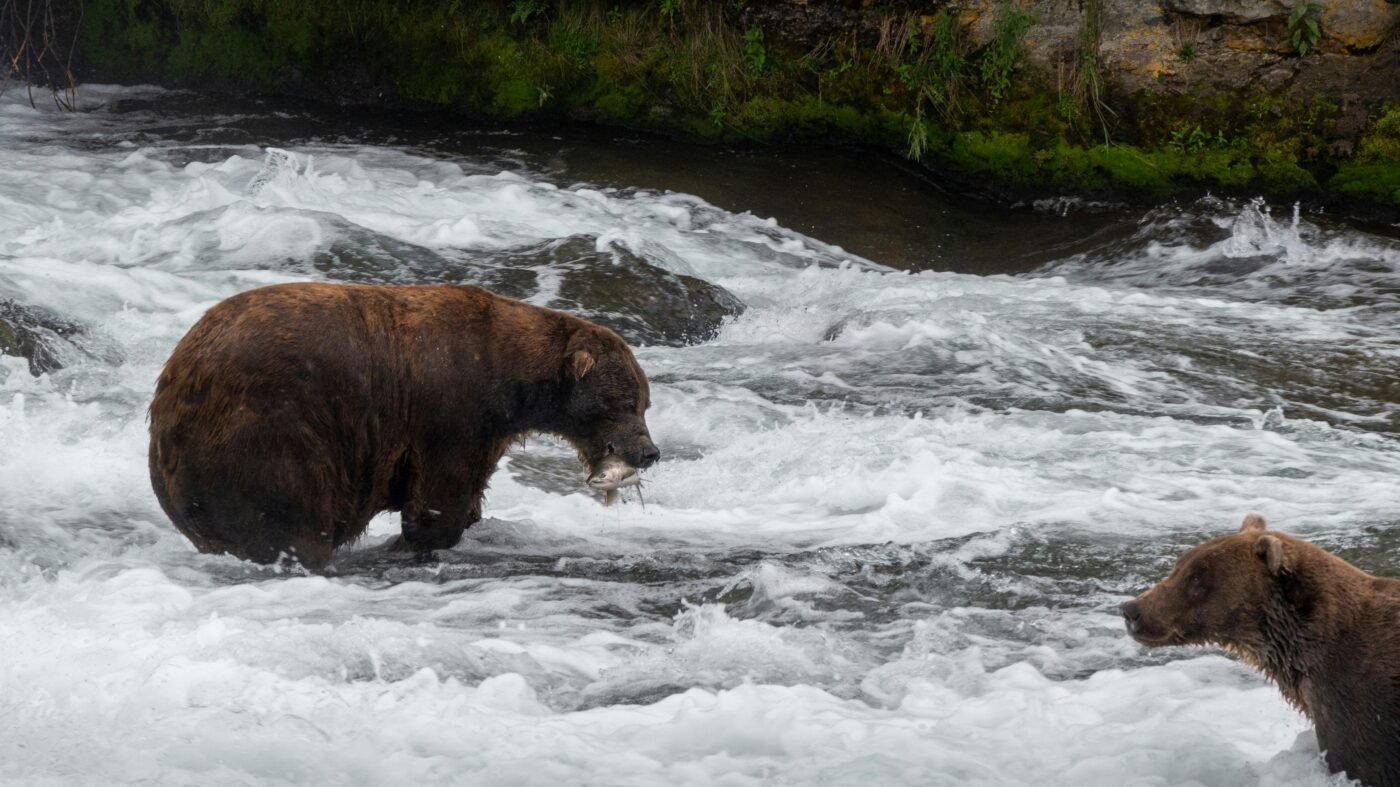Hiking Journal, National Park Journal, Road Trip Journal, United States
Katmai National Park – An Ultimate Guide
Nestled in the heart of Alaska’s wild and rugged wilderness, Katmai National Park and Preserve is a sanctuary for nature enthusiasts, wildlife observers, and adventure seekers. Established in 1918 to protect its unique volcanic landscape, the park now spans over four million acres of pristine natural beauty. It’s particularly renowned for its brown bear population, which draws visitors from around the globe each year. The park’s diverse ecosystems, from coastal areas and lush forests to expansive tundras and volcanic valleys, offer an unparalleled outdoor experience. This comprehensive guide aims to provide you with all the essential information you need to plan an unforgettable trip to Katmai National Park.
Location of Katmai National Park
Katmai National Park is located on the Alaska Peninsula in southwestern Alaska. The park lies approximately 290 miles southwest of Anchorage and is bordered by the Shelikof Strait to the east. The nearest town is King Salmon, which serves as the primary gateway for visitors traveling to Katmai. The park’s remote location, accessible only by air and water, adds to its allure and ensures that it remains a pristine wilderness destination.
Surrounding Katmai are several other notable landmarks, including Kodiak Island to the southeast and Lake Clark National Park and Preserve to the northwest. The park’s geography is characterized by its dramatic volcanic features, most notably the Valley of Ten Thousand Smokes, a vast ash-filled area created by the 1912 eruption of Novarupta. This unique landscape, coupled with the abundant wildlife and stunning scenery, makes Katmai a must-visit destination for anyone seeking to experience the raw beauty of Alaska.
Best Time to Plan Your Visit
The best time to visit Katmai National Park depends on your interests and what you hope to experience. Generally, the most popular time to visit is during the summer months, from June to September. This period offers the most favorable weather conditions and the highest wildlife activity, especially for bear viewing.
Weather Conditions: Summer in Katmai brings milder temperatures, typically ranging from 40°F to 65°F. The weather can be unpredictable, with frequent rain and sudden changes, so it’s essential to pack accordingly. June and July tend to be the driest months, making them ideal for outdoor activities such as hiking, fishing, and kayaking.
Wildlife Activity: The highlight of visiting Katmai is undoubtedly the opportunity to observe brown bears in their natural habitat. The best time for bear viewing is during the salmon runs from late June to September. Bears congregate at Brooks Falls, where they can be seen catching salmon in a spectacular display of nature. This period also offers excellent opportunities for bird watching and spotting other wildlife like moose, wolves, and caribou.
Seasonal Highlights: Each season in Katmai has its unique charm. Spring (April to May) sees the park awakening from its winter slumber, with wildflowers blooming and migratory birds returning. Fall (October to November) offers a quieter experience with fewer visitors and stunning autumn colors. Winter (December to March), though challenging due to extreme weather, provides a pristine, snowy landscape and opportunities for backcountry skiing and snowshoeing for the adventurous.
When planning your visit, consider the weather conditions and wildlife activity to ensure you make the most of your trip to Katmai National Park.
How to Reach Katmai National Park
Reaching Katmai National Park requires careful planning, as it is one of the most remote national parks in the United States. There are no roads leading into the park, so access is primarily by air or water. Here’s a detailed guide on how to get there.
Flying to King Salmon: The most common way to access Katmai is by flying into King Salmon, Alaska. King Salmon is a small town located about 290 miles southwest of Anchorage. Daily commercial flights from Anchorage are available, typically operated by airlines such as Alaska Airlines and Ravn Alaska. The flight from Anchorage to King Salmon takes approximately one hour.
From King Salmon to Katmai: Once you arrive in King Salmon, you’ll need to take a floatplane or a boat to get into the park. The most popular entry point is Brooks Camp, located about 30 miles from King Salmon. Several air taxi services operate from King Salmon, offering floatplane flights to various destinations within the park. These flights provide a scenic aerial view of the park’s stunning landscapes and typically take around 20 minutes.
Boat Transportation: Another option for reaching Katmai is by boat. Some visitors opt to charter boats from King Salmon or other nearby coastal towns. This method is less common but can be an exciting way to explore the park’s coastline and rivers.
Guided Tours and Charters: For those who prefer a more structured experience, several companies offer guided tours and charters to Katmai. These packages often include transportation, accommodations, and guided activities such as bear viewing and fishing trips.
Planning Your Route: Due to the park’s remote nature and the variable weather conditions, it’s essential to plan your route carefully. Make reservations for flights, accommodations, and guided tours well in advance. Be prepared for possible delays due to weather and have a flexible itinerary.
By following these steps, you can ensure a smooth journey to Katmai National Park and maximize your time exploring this incredible wilderness.
Accommodation Options in Katmai National Park
Katmai National Park offers a range of accommodation options to suit different preferences and budgets. From rustic campgrounds to comfortable lodges, here’s a breakdown of where you can stay during your visit.
Brooks Lodge: Brooks Lodge is the most popular lodging option within the park, located near Brooks Camp and Brooks Falls. The lodge offers basic but comfortable accommodations with cabins that can accommodate up to four people. Staying at Brooks Lodge provides easy access to the prime bear viewing areas and other park attractions. The lodge also has a dining hall where meals are served, making it a convenient choice for visitors.
Campgrounds: For those who prefer a more rugged experience, camping is available at Brooks Camp Campground. The campground offers tent sites and basic amenities such as bear-proof food storage lockers, pit toilets, and a small shelter. Camping at Brooks Camp provides a unique opportunity to immerse yourself in the park’s natural surroundings. It’s important to make reservations in advance, as the campground can fill up quickly during peak season.
Accommodations in King Salmon: If you prefer to stay outside the park, King Salmon offers several lodging options, including hotels, motels, and bed-and-breakfasts. Staying in King Salmon allows for a more flexible schedule and the option to take day trips into the park. Accommodations in King Salmon range from basic to more upscale, catering to different needs and preferences.
Backcountry Camping: For the adventurous, backcountry camping in Katmai provides an unparalleled wilderness experience. There are no designated backcountry campsites, so visitors must practice Leave No Trace principles and be prepared for self-sufficient camping. Backcountry campers should obtain a permit from the park rangers and have experience in wilderness survival skills.
Pros and Cons of Each Accommodation Type:
• Brooks Lodge: Pros include proximity to bear viewing areas, guided activities, and included meals. Cons are limited availability and higher cost.
• Campgrounds: Pros include an immersive natural experience and lower cost. Cons are basic amenities and the need for advance reservations.
• King Salmon Accommodations: Pros include flexibility, a range of options, and access to town amenities. Cons are the need for daily transportation to the park.
• Backcountry Camping: Pros include solitude and a deep wilderness experience. Cons are the need for permits, self-sufficiency, and experience in wilderness camping.
Regardless of your choice, staying in or near Katmai National Park offers a unique opportunity to experience one of Alaska’s most spectacular natural areas.
Climate and Seasonal Conditions
Understanding the climate and seasonal conditions of Katmai National Park is crucial for planning your visit and ensuring a safe and enjoyable experience. The park’s weather can be unpredictable and varies significantly with the seasons.
Spring (April to May): Spring in Katmai sees the park transitioning from winter’s grip to the bloom of early summer. Temperatures start to rise, ranging from 30°F to 50°F. Snow begins to melt, making some areas more accessible. This is a quieter time in the park with fewer visitors, offering a peaceful experience. However, be prepared for wet and muddy conditions as the snowmelt progresses.
Summer (June to September): Summer is the peak season for visiting Katmai, with temperatures ranging from 40°F to 65°F. This period offers the most favorable weather conditions for outdoor activities. June and July are the driest months, making them ideal for hiking, fishing, and kayaking. Bear viewing is at its best from late June to September, coinciding with the salmon runs. The long daylight hours of the Alaskan summer provide ample time for exploration and activities.
Fall (October to November): Fall in Katmai is characterized by cooler temperatures and a significant decrease in visitor numbers. Temperatures range from 20°F to 50°F. The autumn colors create a picturesque landscape, and wildlife activity continues, albeit at a reduced level. This is a good time for those seeking solitude and a quieter park experience. Be prepared for colder weather and potential early snowfalls.
Winter (December to March): Winter in Katmai is harsh and challenging, with temperatures often dropping below 0°F. The park is covered in snow, and many areas become inaccessible. However, for the adventurous, winter offers a pristine, snowy wilderness perfect for backcountry skiing and snowshoeing. It’s essential to be well-prepared for extreme cold and have experience in winter survival skills.
Packing Tips for Various Seasons: When visiting Katmai, it’s important to pack appropriately for the season and weather conditions. Layered clothing is essential, as temperatures can vary widely throughout the day. Waterproof and windproof outerwear, sturdy

